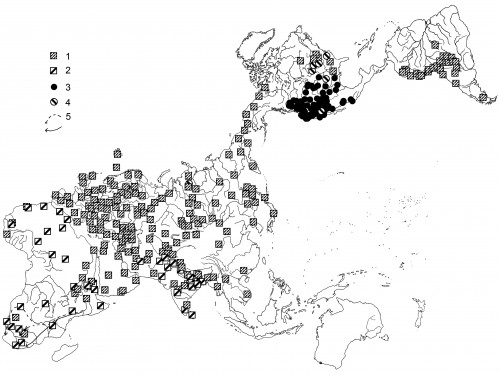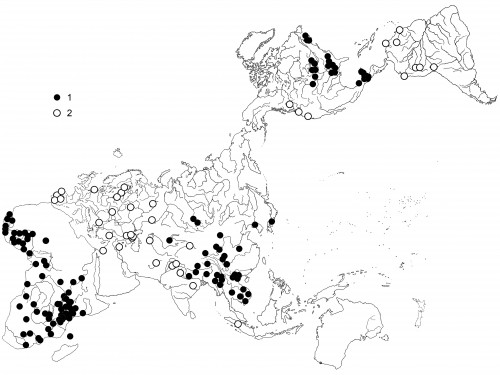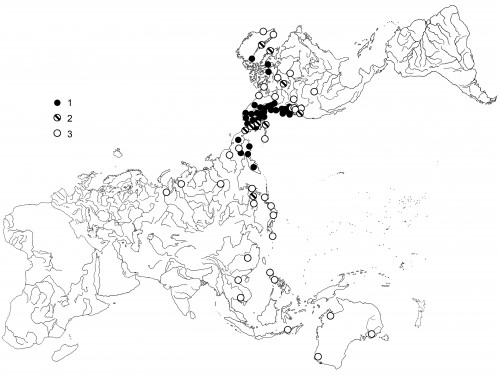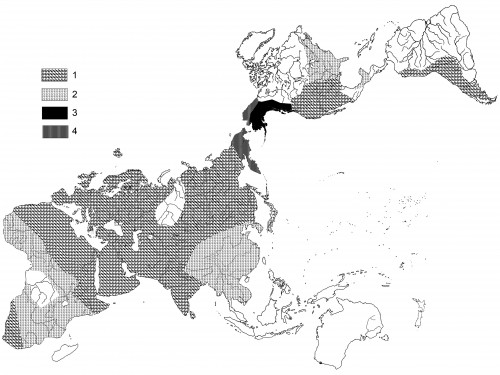World distribution of zoomorphic protagonists of the trickster tales
Yuri Berezkin
Museum of Anthropology & Ethnography (Kunstkamera),
Russian Academy of Science, head of American department
European University at Saint Petersburg, professor
Abstract: Fox/jackal/coyote, hare/rabbit and raven (crow) are three zoomorphic tricksters that are the most widespread in the world folklore. All other have either much more restricted areal distribution or, being widely known, participate in a restricted number of episodes and only rarely (the monkey) or probably never (turtle) become the attractors of a vast number of diverse trickster episodes. Unlike them, everyone of the “real” trickster occupies a vast but restricted area. The fox/jackal has no rivals across Europe, Eastern and Southern Siberia, Central, Southwestern and South Asia, Northern and Northeastern Africa. In the New World the trickster-coyote is widespread in western North America and the trickster-fox in the Central-South Andes, Chaco and Patagonia. The hare/rabbit is the predominant trickster in sub-Saharan Africa and in Southeastern and East Asia and is widespread in Eastern North America. An isolated enclave of fox/coyote in Southwestern Africa seems to be related to the southward movement of cattle-breeders from present day Kenya – Tanzania ca. 200 B.C. – A.D. 200. The trickster-raven is peculiar for the northern Pacific on both Asiatic and American sides with a vague trace along the Pacific belt of Asia down to southeastern Australia. Both trickster-raven and trickster-fox were brought to American Arctic by the Eskimo. Areas of the predominant spread of the major animal tricksters do not coincide with the areas of the spread of particular types of animal tales. The zoomorphic characteristics of the tricksters across particular areas seem to be extraordinary stable while the particular tale-types easily cross the regional borders with zoomorphic identity of protagonists changed accordingly to regional norms. The world distribution of the most popular zoomorphic tricksters can have its roots in the remote epoch of the initial spread of modern man from Africa and emergence of major cultural areas. The spread of particular tale-types was a much later phenomenon.
Keywords: animal tales, trickster fox, trickster hare, trickster raven, peopling of America, African folklore, folklore databases.
Résumé: Le renard/chacal/coyote , le lièvre/lapin et le corbeau (corneille) sont les trois décepteurs zoomorphes les plus répandus au sein du folklore mondial. Tous les autres ont soit une distribution spatiale beaucoup plus restreinte, ou , s'ils sont largement connus, ne participent qu'à un nombre limité d'épisodes et rarement (le singe) ou probablement jamais (la tortue) ne deviennent les attracteurs d'un grand nombre de divers épisodes de décepteurs. Contrairement à eux, chacun des décepteurs « réels » occupe une superficie très vaste, mais bien définie. Le renard / chacal n'a pas de rivaux à travers l'Europe, la Sibérie orientale et méridionale, l'Asie centrale, du Sud et du Sud-Ouest, l'Afrique du Nord et du Nord-Est. Dans le Nouveau Monde le décepteur - coyote est très répandu dans l'ouest de l'Amérique du Nord et le décepteur - renard dans les Andes du Centre-Sud, dans le Chaco et la Patagonie. Le lièvre / lapin est le décepteur prédominant en Afrique sub-saharienne et en Asie orientale et sud-orientale ; il est très répandu dans l'Est de l'Amérique du Nord. Une enclave isolée de renard / coyote en Afrique du Sud-Ouest semble être liée à la migration vers le Sud, vers 200 avant J.-C. - 200 après, d'éleveurs venus des actuels Kenya – Tanzanie. Le décepteur - corbeau est particulier au Pacifique Nord, côté asiatique et américain, avec une vague trace le long de la ceinture Pacifique de l'Asie, jusque vers le Sud-Est de l'Australie. Les deux décepteur - corbeau et décepteur - renard ont été amenés dans la zone arctique de l'Amérique par les Esquimaux. Les domaines de propagation prédominants des grands décepteurs animaux ne coïncident pas avec les domaines de propagation de certains types de contes d'animaux. Les caractéristiques zoomorphes des décepteurs dans des domaines particuliers semblent extraordinairement stables tandis que les contes-types particuliers traversent facilement les frontières régionales en modifiant l'identité zoomorphe des protagonistes changé en selon les normes régionales. La distribution mondiale des décepteurs zoomorphes les plus populaires peut avoir ses racines dans l'époque reculée de la propagation initiale de l'homme moderne hors d'Afrique et de l'émergence de grandes aires culturelles. La propagation de certains contes-types est un phénomène beaucoup plus tardif.
Mots clés : contes d'animaux, décepteur renard, décepteur lièvre, décepteur corbeau, peuplement de l'Amérique, folklore africain, bases de données sur le folklore.
Télécharger l'article en pdf / download in pdf: Berezkin.pdf
Cité par / quoted by:
Juliend'Huy, « Une nouvelle méthode, rapide et efficace, pour reconstruire les premières migrations de l'humanité », Mythologie française, 259, 2015,p. 66-82.
The article is based on materials from the author’s electronic catalogue of the world mythology and folklore that contains ca. 50,000 abstracts of texts registered according to 900 selected local traditions1. The areal distribution is checked for almost 1900 motifs. All these numbers are continuously increasing, the number of selected traditions thanks to the splitting of big ethnic clusters into the smaller ones. The database in its textual format is available in Russian at http://www.ruthenia.ru/folklore/berezkin and is upgraded every January. We are working now to create a more sophisticated site with the English wordings of motifs and maps of the world distribution of motifs according to the selected areas. In 2014 the research is supported by the Russian Fund for Basic Research, project 14-06-00247.
Most of the analytical units that I call “motifs” can be also named “episodes”. F. Boas and his colleagues in late XIX – early XX centuries named them “elements” or “catch-words” (Boas 1895: 345; 2002: 652; Kroeber 1908). They are similar to the “tale-types” of Aarne-Thompson-Uther (ATU) system (Uther 2004) but unlike the latter do not have variants. All texts retold in connection with the same “motif” should contain all the details mentioned in the wording of the motif. Our database also contains information on distribution of simple motifs related to ideas concerning cosmology, animals and plants, fantastic beings, etc. Some of these simple motifs fit definitions suggested by S. Thompson (1955-1958) but most of his elementary motifs (like “Creation of man by creator” or “Magic control of rainbow”) are too unspecific to be used for tracing historical links between different traditions.
The ATU system accentuates information on actions and practically ignores information on actors. In case of the animal tales a typical wording is like this: “A fox (hare) asks the children of the mother bear (wolf, fox, lioness) about their mother…” (ATU 36). Because of this it is often impossible to understand from the ATU-type indexes, who in particular (a fox, a hare or somebody else) is the actor. The processing of the mass material demonstrates, however, that the recording of the identity of the actors has a potential of revealing extraordinarily stable and probably very early cultural borders. The choice of a particular animal actor depends not only on the peculiarities of local fauna but on traditional preferences. The animal prototypes of the three zoomorphic tricksters that are in focus or our study have a practically world-wide distribution. Therefore the role played by these tricksters in folklore traditions does not depend on climates and landscapes where the people live.
The identification of zoomorphic tricksters according to animal species is a more stable characteristic of folklore traditions than a set of particular episodes in which the tricksters are involved. Being borrowed, stories preserve their structure but the identification of the protagonists is usually changed to fit regional standard. Thence somewhat absurd situations like an East African hare tricking a bird to throw him a nestling to eat. It is a result of the borrowing of the North African–Eurasian tale where the protagonist was a fox.
For this paper, 160 episodes have been selected as typical trickster motifs. Here are a few examples. Motif B38 (according to classification in our catalogue): person paints birds or animals or they paint each other and the trickster is an animal unsatisfied with the color received. Motif F81: person mistakes his own reflection in river for a beautiful woman, makes attempt to marry her, falls into water. Motif M32: food or liquid that person swallows are immediately pouring out from his bottom part. Motif M124: person buries a tail or head of a bull or other domestic animal with a tail or horns outside and explains that the animal sank into the ground. Motif M156: person saves a dangerous creature; the latter is going to kill its savior; the trickster pretends to be eager to see the original situation and the creature is imprisoned again or killed.
In most of the trickster stories the protagonists can be either anthropomorphic or zoomorphic but only the zoomorphic ones are treated here.
Three zoomorphic tricksters are the most widespread in the world folklore. These are fox/jackal/coyote, hare/rabbit, and raven (much more rare: crow). Hare and rabbit being different animal species correspond to one and the same folklore actor, their roles in particular tales are always identical. Fox, jackal and coyote also easily replace each other in stories and can be treated together. In very rare cases a dog or a wolf play the same role but normally neither of them is the trickster.
Fig. 1.
The Canidae tricksters. 1. Fox. 2. Jackal. 3. Coyote.
4. Wolf (in North America) or dog (among the Dolgans).
5. The southward movement of East African cattle breeders ca. 2000 years ago, after (Smith 1992, fig. 1).
Click on the map to enlarge.
Among the selected traditions, fox/jackal/coyote is registered for 328, rabbit or hare for 155, and raven or crow for 75. All other zoomorphic tricksters have either much more restricted areal distribution or, being widely known, participate in a restricted number of episodes and only rarely (the monkey) or probably never (turtle) become the attractors of a vast number of diverse trickster episodes and can be named the “real” tricksters.
In the Old World, the fox/jackal is absolutely dominant across most of Northern and Central Eurasia and North Africa (fig. 1) while the hare is dominant in the sub-Saharan Africa and Southeast and East Asia (fig. 2). As about the last region, we have abundant data on Tibet, Southeast Asia and Korea while the data on the Chinese animal tales are scarce. The N.-T. Ting's (1978) index is useless because it does not specify the data according to provinces, not to say ethnic groups. The W. Eberhard's publications (1937; 1965) are more informative but do not include the abundant folklore materials published in Chinese during the last half a century. Though I am not completely sure that the core zone of Chinese ethnic area has the trickster rabbit tradition, no other popular tricksters are reported for it either. As much as I know, the trickster hare stories are not recorded among the natives of Taiwan but published Taiwanese animal tales are also few.
For Japan we have trickster hare in Kojiki and Nihon Shoki and trickster fox in the late folklore (Ikeda 1971, nos. 1-2). However, the Japanese folklore fox is not an attractor of a cycle of tales and shares its trickster role with other animals. In many cases it plays a role of a dupe that in continental Eurasia and in Africa is usually played by a wolf, a bear or a hyena.
The border that separates the sub-Saharan African trickster hare from North African and Eurasian trickster fox/jackal coincides with the major linguistic and genetic borders that separate the sub-Saharan populations from all the others. Because during the Late Pleistocene the sub-Saharan Africa was largely isolated from the rest of the world (Barham, Mitchell 2008: 265), the sub-Saharan and the North African–Northern Eurasian folklore traditions developed independently.
In Africa an isolated enclave of the trickster fox/jackal is found in the southwest of the continent. In Central and East Africa we have but several unique stories with the fox/jackal as the protagonist but among the Koisan and Bantu groups of southwest part of Africa such stories are typical. The precise border between the fox/jackal and the hare zones in South Africa lies between the ethnic territories of the Kosa (Xhosa) and the Zulu. This Southwest African enclave seems to emerge thanks to the migrations of cattle breeders from northern areas of the East Africa 2200-1800 years ago (Berezkin 2013: 232-234; Orton et al. 2013; Pleurdeau 2012; Plug & Voigt 1985; Smith 1992).
The fox/jackal is typical for Arabian peninsular and for Kushitic and Semitic Africa. The data on the Omotic groups of Southwestern Ethiopia are restricted but the Omotic folklore tradition seems to be stronger influenced by the non Afroasiatic substratum than the Kushitic one. The Kushitic and Semitic folklore contains many specific links with the more northern territories of Eurasia. These traditions probably replaced completely the earlier ones that existed in South Arabia and across the African Northeast during the Pleistocene. Arabia could be a bridge between the sub-Saharan African and the Southeast Asian zones of trickster hare. The independent emergence of the trickster hare/rabbit in Africa and in Asia cannot be completely excluded. However, we have other folklore parallels between the sub-Saharan Africa and the Indo-Pacific borderlands of Asia (Berezkin 2009a; 2009b; 2010b; 2010c; 2013), so the existence of historic connections between two major areas of the spread of the trickster hare/rabbit should be considered as possible.
An important gap in the trans-Eurasian distribution of the trickster fox exists in Western Siberia. In local traditions episodes with participation of a fox are rare and in the Enets and Northern Sel'kup traditions seem to be absent completely. This contrasts with a great popularity of the trickster fox in the Eastern Siberian, Altai-Sayan, Kazakhstan and East European folklore. A typical Western Siberian trickster is anthropomorphic (Yombu, Ekwa-Pygris, Dea, Icha, etc.). Unlike most of the other Eurasian anthropomorphic tricksters that look like a recent replacement of the zoomorphic ones, the Western Siberian anthropomorphic tricksters can have early origins. These personages are involved into a series of particular episodes shared by native groups of the Northeastern Siberia and Northwestern North America.
In sub-Saharan Africa a gap in distribution of trickster hare exists in Congo basin. An influence of the pre-Bantu substratum is a possible explanation though at least among the Aka Pigmies the trickster is just the hare (Trilles 1932: 318-321).
In the western parts of the U.S. the northern border of distribution of trickster coyote approximately coincides with the southern border of the glaciers at 13-15,000 years ago. It is an argument in favor of the hypothesis that this folklore image had been brought to the main part of New World before the glaciers melted though not by the very first migrants to the New World. The thing is that the trickster coyote is rare to the east of the Rockies and especially to the east of Mississippi. Its predominance across the American West correlates with a number of other folklore motifs widespread to the west of the Rockies and very probably related to the spread of the Protowestern tradition of the stemmed points of Terminal Pleistocene – Early Holocene (Berezkin 2010a: 270-271).
Fig. 2.
Rabbit or hare as a trickster.
1. Typical, engaged into many episodes. 2. Rare cases, one episode.
Click on the map to enlarge.
The trickster fox is known to the American Eskimo but this penetration is unrelated to the main episode of the introduction of the fox/coyote as a trickster figure into the New World. There were several movements of peoples with the Eskimo type of culture from Alaska to Greenland, the earliest of them dated to the mid III millennium B.C. and the last one (the Tule migration) as late as 800-700 years ago (Friesen & Arnold 2008; Sørensen & Gulløv 2012: 100).
The Andean-Chacoan-Patagonian area of the trickster fox in South America is probably related to the same migration episode as the North American trickster coyote. Some of particular trickster motifs are shared by the corresponding North and South American groups.
The European influence is responsible for distribution of some episodes related to the trickster fox in the Andes and in South Africa. However, in both cases most of the stories with the fox as a protagonist do not find direct parallels in Europe and the very adoption of several European tales could be facilitated by the similar zoomorphic identity of the trickster in the folklore of the native people and the colonists.
The Eastern North American and the Mesoamerican areas of the trickster rabbit can be provisionally attributed to the early East Asian tradition. The scenes on Classic Maya painted vessels with the rabbit involved into activity that can be interpreted as scenes of deception (Berezkin 2003; Grofe 2009: 2) supports the pre-Columbian age of this image in Mesoamerica. There is no doubt that across the American Southeast and to a lesser extent across Mesoamerica the late African influence on the Indian folklore was strong. However, most of the stories borrowed from the black slaves have direct parallels in West Africa and it is not difficult to select them from stories of local Indian origin. The more rare South American cases of trickster rabbit are not so clear and here I do not dare to make a choice in favor of the local origin or the post-Columbian borrowing.
Fig. 3.
Raven (crow) as a trickster. 1. Typical, engaged into many episodes. 2. More rare cases, two different episodes. 3. Rare cases, one episode.
Click on the map to enlarge.
The trickster raven is the dominant image across the Northwest North America (fig. 3) while among the Paleoasiatic and the Inuit groups both the raven and the (polar) fox are widespread. The remote origins of the trickster raven tradition must be located in Pacific borderlands of Asia where isolated trickster motifs with the raven protagonist are recorded as far to the south as Australia. The area of the trickster raven in the Northern Pacific looks like a heritage of the ancient Beringia where the ancestors of the American natives lived before they were able to move further south. If the trickster raven reached Alaska only in the Holocene, we should expect survivals of other trickster figures in the folklore of the Tlingit and their neighbors. However, across all Alaska and the Northwest Coast the trickster raven is much more popular folklore figure than any other while among the Denaina, Eyak, Tlingit, Tsimshian and Haida the raven is the only protagonist of trickster stories.
Why the trickster raven had not been brought to the American mainland by the first Beringia migrants? A plausible explanation is a chance disappearance of some cultural traits in a small ancestral population after its movement to the new territories. The interest in trickster tales can be one of such traits. It is significant that across Lower Central America, Eastern South America and Tierra del Fuego we do not have any tricksters at all, only isolated episodes related to different zoomorphic or anthropomorphic actors. People who brought the trickster fox to the Andean-Chacoan-Patagonia area and the trickster coyote to the North American West probably experienced a more intense cultural interaction with the Siberian bearers of the trickster fox tradition than the inhabitants of Beringia.
Fig. 4.
Scheme of world distribution of three most widespread zoomorphic tricksters.
1. Fox/jackal/coyote. 2. Hare/rabbit. 3. Raven (crow). 4. Raven and (polar) fox in approximately equal proportion.
Click on the map to enlarge.
Along with processing of the new data the picture of the world distribution of the zoomorphic tricksters will become ever more detailed but the major trends revealed now will hardly be put to doubt. The existence of three major zones of trickster tales in the Old World (fox/jackal across most of Eurasia and North Africa, hare/rabbit across the sub-Saharan Africa and also hare/rabbit across Southeast and East Asia) is certain (fig. 4). The distribution of the tricksters across the New World reflects the main episodes of the peopling of the Americas from the earliest Paleoindians to the arrival of the European colonists and African slaves.
Barham, Lorence, & Peter Mitchell. 2008. The First Africans. African Archaeology from the Earliest Tool Makers to Most Recent Foragers. Cambridge: Cambridge University Press. 601 p.
Berezkin, Yuri. 2003. Trikster krolik: ikonografia maia i fol'klor indeitsev severoamerikanskogo Yugo-Vostoka [Trickster rabbit: Maya iconography and Southeast Indians' folklore]. Drevnie Tsivilizatsii Starogo i Novogo Sveta: Kul'turnoe Svoyeobrazie i Dialog Interpretatsii [Ancient Civilisations of the Old and New Worlds. Cultural Peculiarity and the Dialogue of Interpretations], Dmitry Belyaev & Galina Yershova, eds. Moscow: Russian State University of the Humanities, pp. 53-59.
Berezkin, Yuri E. 2009a. Out of Africa and further along the Coast (African - South Asian - Australian mythological parallels). Cosmos: The Journal of Traditional Cosmology Society (Edinburgh) 23(1): 3-28.
Berezkin, Yuri E. 2009b. Why are People Mortal? World Mythology and the "Out-of-Africa" Scenario. Ancient Human Migrations. A Multidisciplinary Approach. Edited by Peter N. Peregrine, Ilia Peiros, and Marcus Feldman. Salt Lake City: The University of Utah Press, pp. 242-264.
Berezkin, Yuri. 2010a. Selecting separate episodes of the peopling of the New World: Beringian–Subarctic–Eastern North American folklore links. Anthropological Papers of the University of Alaska 5 (1-2): 257-276. (The Dene-Yeniseian Connection, ed. by James Kari & Ben A. Potter. Fairbanks: University of Alaska).
Berezkin, Yuri. 2010b. The emergence of the first people from the underworld: Another cosmogonic myth of a possible African origin. New Perspectives on Myth. Proceedings of the Second Annual Conference of the International Association for Comparative Mythology. Ravenstein (the Netherlands), 19-21 August, 2008. Wim M.J. van Binsbergen & Eric Venbrux, eds. Haarlem: An African Journal of Philosophy / Revue Africaine de Philosophie, pp. 109-125.
Berezkin, Yuri E. 2010c. From Africa and back: some areal patterns of mythological motifs. Mother Tongue, Journal of the Association for the Study of Language In Prehistory. Fifteen Anniversary Issue. P. 1-67.
Berezkin, Yuri. 2013. Afrika, migratsii, mifologia. Areal'noe raspredelenie fol'klornyh motiviv v istoricheskoi perspektive [Africa, Migrations, Mythology. Areal Patterns of the Folklore Motifs in the Historical Perspective]. Saint Petersburg: Nauka.
Boas, Franz. 1895. Indianische Sagen von der Nordpazifischen Küste Amerikas. Berlin: Asher. 363 S.
Boas, Franz. 2002 Indian Myths and Legends from the North Pacific Coast of America. Vancouver: Talonbooks. 702 p.
Eberhard, Wolfram. 1937. Typen chinesischer Volksmärchen. Helsinki: Suomalainen Tiedeakatemia. (FF Communications 120).
Eberhard, Wolfram. 1965. Folktales of China. Chicago: University of Chicago Press; London: Routledge & Kegan Paul.
Friesen, T. Max & Charles D. Arnold. 2008. The timing of the Thule migration: new dates from the Western Canadian Arctic. American Antiquity 73(3): 527-538.
Ikeda, Hiroko. 1971. A Type and Motif Index of Japanese Folk-Literature. Helsinki: Suomalainen Tiedeakatemia. (FF Communications 209). 375 p.
Kroeber, Alfred L. 1908. Catch-words in American mythology. Journal of American Folklore 21(81-82): 222-227.
Grofe, Michael J. 2009. The name of god L: B'olon Yokte' K'uh? Wayeb notes 30: 1-19.
Orton, Jayson, Peter Mitchell, Richard Klein, Teresa Steele & K. Ann Jorsburgh. 2013. An early date for cattle from Namaqualand, South Africa: implications for the origins of herding in southern Africa. Antiquity 87(335): 108-120.
Pleurdeau, David, Imalwa E., Détroit F., Lesur J., Veldman A., et al. 2012. "Of Sheep and Men": earliest direct evidence of caprine domestication in Southern Africa at Leopard Cave (Erongo, Namibia). PLoS ONE 7(7): e40340.
Plug, Ina & Elizabeth A. Voigt. 1985. Archaeological Studies of Iron Age communities in South Africa. Advances in World Archaeology 4: 189-238.
Smith, Andrew B. 1992. Origins and spread of pastoralism in Africa. Annual Review of Anthropology 21: 125-141.
Sørensen, Mikkel & Hans Christian Gulløv. 2012. The prehistory of Inuit in Northeast Greenland. Arctic Anthropology 49(1): 88-104.
Ting, Nai-Tung. 1978. A Type Index of Chinese Folktales. Helsinki: Suomalainen Tiedeakatemia. (FF Communications 223).
Thompson, Stith. 1955-1958. Motif-index of Folk-literature. Vols. 1-6. Bloomington: Indiana University Press.
Trilles, R.P. 1932. Les Pygmées de la Forêt Équatoriale. Paris: Librairie Vloud & Gay. 530 p.
Uther, Hans-Jörg. 2004. The Types of International Folktales. Parts 1-3. Helsinki: Suomalainen Tiedeakatemia.
1Research supported by Russian Fund for Basic Research, project no.14-06-00247.



